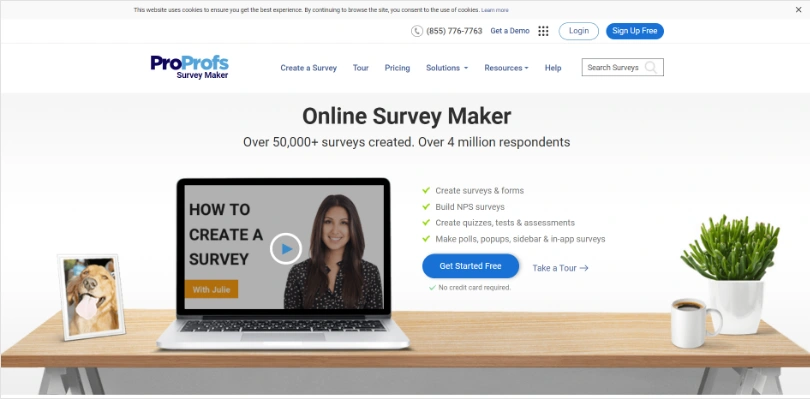Every founder eventually hits the same wall. You collect plenty of feedback, but once the volume picks up, the signal gets muddy. A simple comment like “The new update is interesting” can turn into a 10-minute debate about whether the user loves it or hates it. I’ve sat through enough product meetings to know that guessing sentiment is a terrible use of time.
Good sentiment analysis tools solve that. They cut through polite wording, mixed emotions, and vague survey responses. The weaker tools do the opposite; they mislabel half your data and create more work than they remove.
My goal here is to help you skip the trial-and-error phase. I’ll walk through the tools that actually deliver, where they fall short, and which ones fit real workflows across product, support, and research. By the end, you’ll know exactly which tool fits your stack and your stage.
Let’s get into it.
What Are Sentiment Analysis Tools?
Sentiment analysis tools help you understand the emotion behind customer feedback at scale. Instead of taking every comment at face value, they tell you whether the underlying sentiment is positive, negative, neutral, or somewhere in between.
They’re useful once you’re dealing with more feedback than your team can reliably read. A dozen comments are manageable. A few hundred across surveys, support tickets, and reviews aren’t. That’s where sentiment analysis tools step in: they turn unstructured text into clear signals so you’re not guessing what users meant or debating tone in every meeting.
In short, sentiment analysis tools help you move from reacting to scattered comments to spotting real patterns in how customers feel.
Now, let’s look at how the top tools compare side by side.
Comparison Table: The Best Sentiment Analysis Tools
When you’re choosing a sentiment analysis tool, the real question isn’t “What does it do?” but “Where does it actually save me time?” This table gives you the quick version. Before we get into the deeper breakdowns, here’s how the top tools stack up on the basics: who they’re built for, what they’re best at, how much they cost to get started, and how users rate them in the wild.
| Tool | Best For | Key Strength | Starting Pricing | User Rating |
|---|---|---|---|---|
| Qualaroo | Product/UX teams collecting survey feedback | Embedded surveys + IBM Watson–powered sentiment | From $19.99/month; free plan available with all premium features | 4.7/5 (Capterra) |
| ProProfs Survey Maker | Agencies or teams focused on open-ended survey responses | AI survey builder + self-service sentiment analysis | From $19.99/month; free plan available | 4.8/5 (Capterra) |
| Enterpret | Product/feedback-driven teams needing unified insight | LLM-powered feedback analytics + multi-channel views | Custom quote (volume-based) | 4.5/5 (G2) |
| Clootrack | Enterprise teams tracking multi-channel feedback and sentiment | AI-driven theme + sentiment detection across reviews, social, surveys | Custom quote | 4.6/5 (G2) |
| Lexalytics | Enterprises needing deep-context models & on-prem deployment | Industry-specific NLP + entity + sentiment | From $10,000 (basic cloud analytics | 4.3/5 (G2) |
| Brandwatch | Brand/social teams monitoring web & social mentions | Real-time sentiment, listening, large data coverage | Custom quote | 4.4/5 (G2) |
| Talkwalker | Global teams tracking sentiment across news, social, forums | Multichannel, multilingual coverage | Custom quote | 4.3/5 (G2) |
| Sprout Social | Social-management teams wanting built-in sentiment | Engagement + sentiment in one platform | From $199/seat/month | 4.4 (G2 & Capterra) |
| Medallia | Enterprise CX programmes | Full-scale feedback + sentiment across channels | Custom quote | 4.5/5 (G2) |
| Amazon Comprehend | Teams already using AWS and want sentiment API | Highly scalable; integrates in AWS workflows | From $0.0001 per unit (up to 10M units) | 4.2/5 (G2) |
10 Best Sentiment Analysis Tools: In-depth Review
The table gives you the snapshot, but snapshots only go so far. The real differences show up in day-to-day use. In this section, I’ll break down each tool with a clear look at what it’s good at, where it struggles, and when it actually makes sense to use it:
1. Qualaroo
Qualaroo is the tool I’ve relied on whenever I need sentiment analysis directly inside the product experience. It’s quick to deploy, easy to target, and doesn’t require rebuilding your feedback workflow. You place a nudge on a page or flow, and you immediately start collecting contextual responses. IBM Watson handles the sentiment scoring on open-ended answers, which removes the guesswork from vague comments users tend to leave. It’s a low-maintenance way to get continuous, in-product insight.
Best For: Teams that want on-site or in-product sentiment analysis without stitching together multiple tools.
Key Features
- AI-powered sentiment analysis by IBM Watson
- In-product nudges and micro-surveys
- Advanced targeting (behavioral, device, URL, custom events)
- Conditional logic and branching
- Survey templates for product, UX, and research
- Seamless integrations with HubSpot, Salesforce, Slack, Google Analytics, and more
- Mobile-friendly and low-impact on performance
Pros
- Very quick to launch targeted surveys
- Great at capturing UX friction in real time
- Lightweight script that won’t slow down your product
- Sentiment is analyzed at the point of feedback
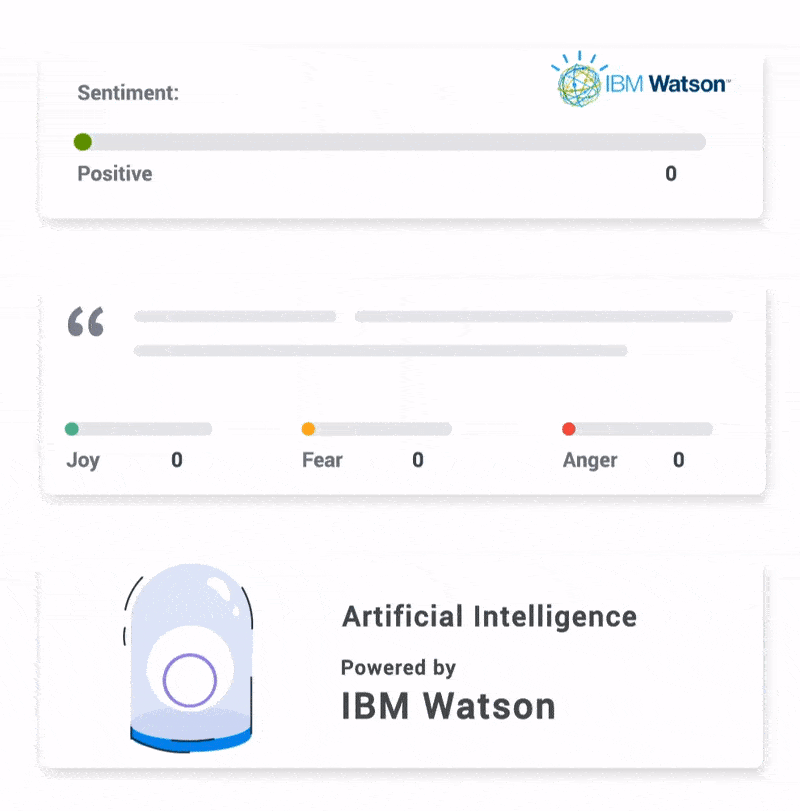
Cons
- No dark theme available
- No on-premise version available
Pricing: Free plan available with all premium features. Paid plans start at $19.99/month.
User Rating: 4.7/5 (Capterra)
2. ProProfs Survey Maker
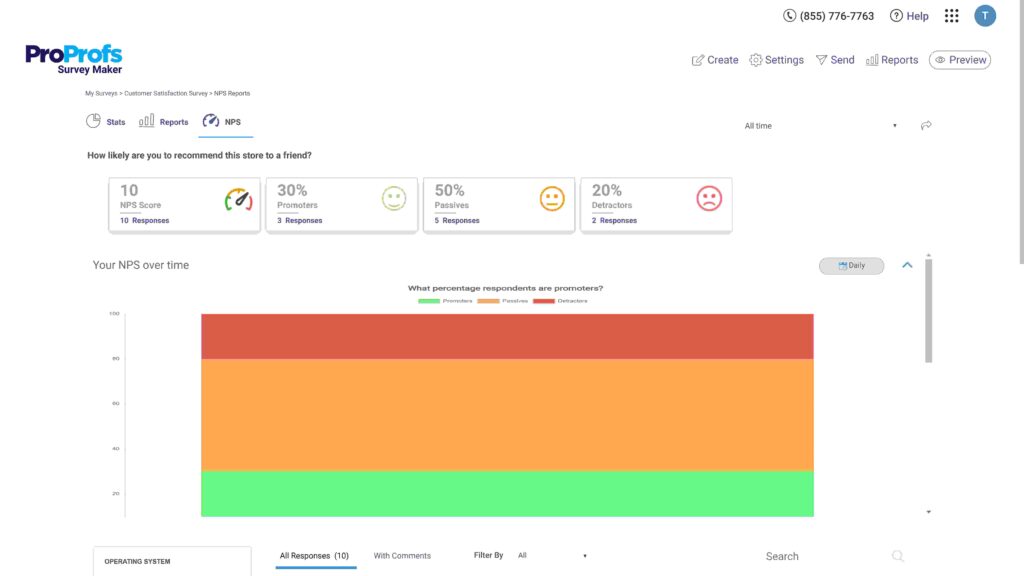
I’ve used ProProfs Survey Maker when I needed a fast way to spin up surveys without involving design or engineering. The AI survey builder is genuinely useful here. It gets you from idea to draft far quicker than a blank form ever will. For open-ended responses, the built-in sentiment analysis gives you a clean read on tone without having to manually code comments. It’s simple, predictable, and works well if surveys are the core of how you gather feedback.
Best For: Teams and agencies that rely heavily on surveys and need sentiment analysis built directly into the reporting.
Key Features
- AI-powered survey builder
- Built-in sentiment analysis for open-ended feedback
- 100+ templates for product, marketing, HR, and customer feedback
- Drag-and-drop editor with logic, scoring, and branching
- Email, link, website, and in-app distribution
- Dashboards and detailed reporting
- Integrations with CRM, help desk, marketing, and analytics tools
- Supports NPS, CSAT, and custom scoring models
Pros
- Very easy to build and publish surveys
- AI survey creation saves a lot of setup time
- Strong reporting and sentiment breakdowns
- Flexible distribution options
Cons
- No dedicated account manager available for free plan
- You’d require an Internet connection to use the platform
Pricing: Starts from $19.99/month. Free plan available
User Rating: 4.8/5 (Capterra)
3. Enterpret
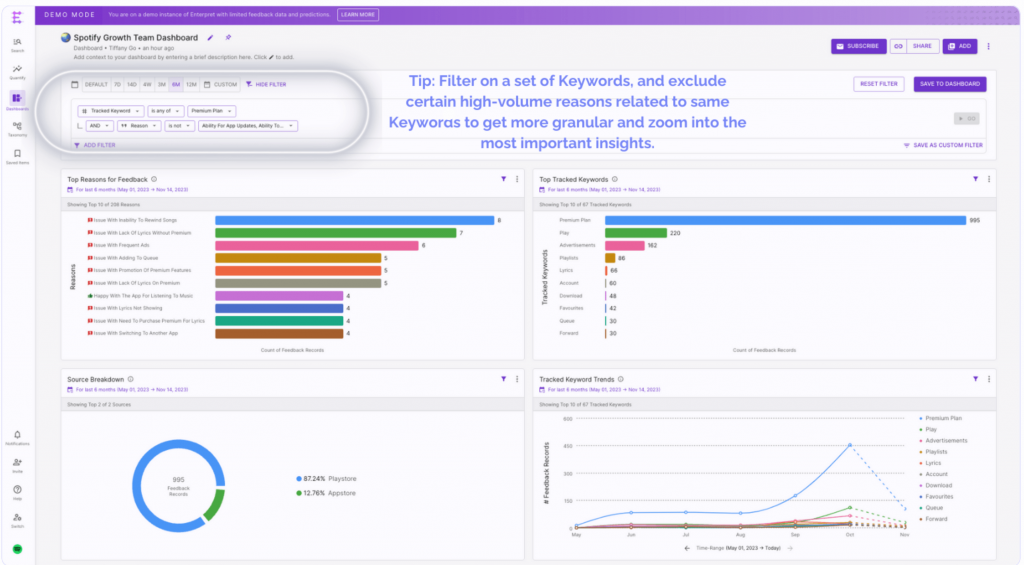
I first came across Enterpret when a product team mentioned they were finally able to pull support tickets, survey responses, app reviews, and community posts into one place without duct-taping dashboards together. That’s the gap Enterpret fills. It doesn’t just score sentiment, but centralizes feedback from every channel and uses LLMs to cluster themes, identify patterns, and show what’s driving changes in user sentiment. It’s built for teams drowning in feedback spread across too many tools.
Best For: Teams that need a unified, AI-driven view of customer feedback across multiple channels.
Key Features
- LLM-powered sentiment and theme detection
- Unified repository for surveys, tickets, reviews, and community feedback
- Trend tracking across product areas, releases, and segments
- Custom taxonomies for product and UX teams
- Integrations with support platforms, analytics tools, and data warehouses
- Strong filtering and drill-down capabilities for root-cause analysis
Pros
- Excellent at consolidating fragmented feedback
- Strong at surfacing themes and patterns automatically
- Helps teams understand “why” sentiment shifts are happening
Cons
- Pricing is custom, so harder to estimate upfront
- Best suited for teams with multiple feedback channels, not single-source setups
Pricing: Custom quote (volume and integration-based)
User Rating: 4.5/5 (G2)
4. Clootrack
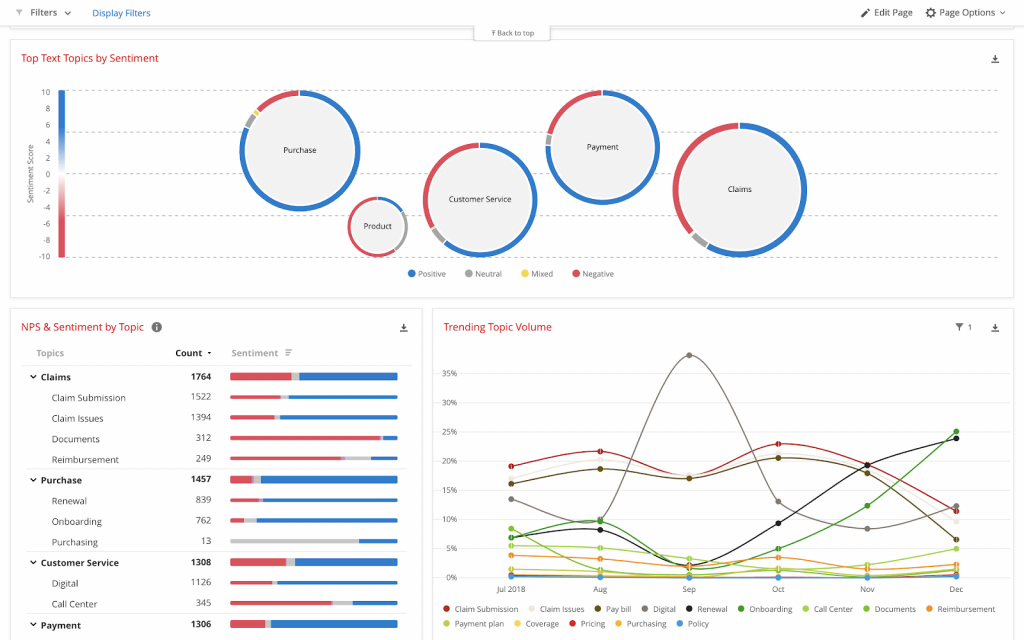
I first heard about Clootrack from a team that was trying to make sense of thousands of product reviews and social mentions without spending weeks tagging everything manually. Their feedback was simple: Clootrack handled scale in a way most tools don’t. It’s built for deep, AI-driven analysis across large datasets — reviews, forums, social, surveys — and it’s good at extracting themes and pinpointing what’s actually driving sentiment shifts. If you’re working with high-volume, multi-channel feedback, this is where Clootrack tends to stand out.
Best For: Enterprise teams that need detailed, multi-channel sentiment and theme analysis at scale.
Key Features
- AI-powered sentiment and emotion detection
- Automatic theme and topic extraction across channels
- Multi-language support
- Real-time trend tracking
- Custom dashboards and reporting
- Integrations for importing reviews, survey data, and social feeds
- Root-cause analysis across product categories or segments
Pros
- Strong at processing very large feedback datasets
- Accurate theme detection with granular drill-downs
- Useful for category-level and competitive insights
Cons
- Pricing is enterprise-focused
- Overkill for smaller teams with minimal feedback volume
Pricing: Custom quote
User Rating: 4.6/5 (G2)
5. Lexalytics
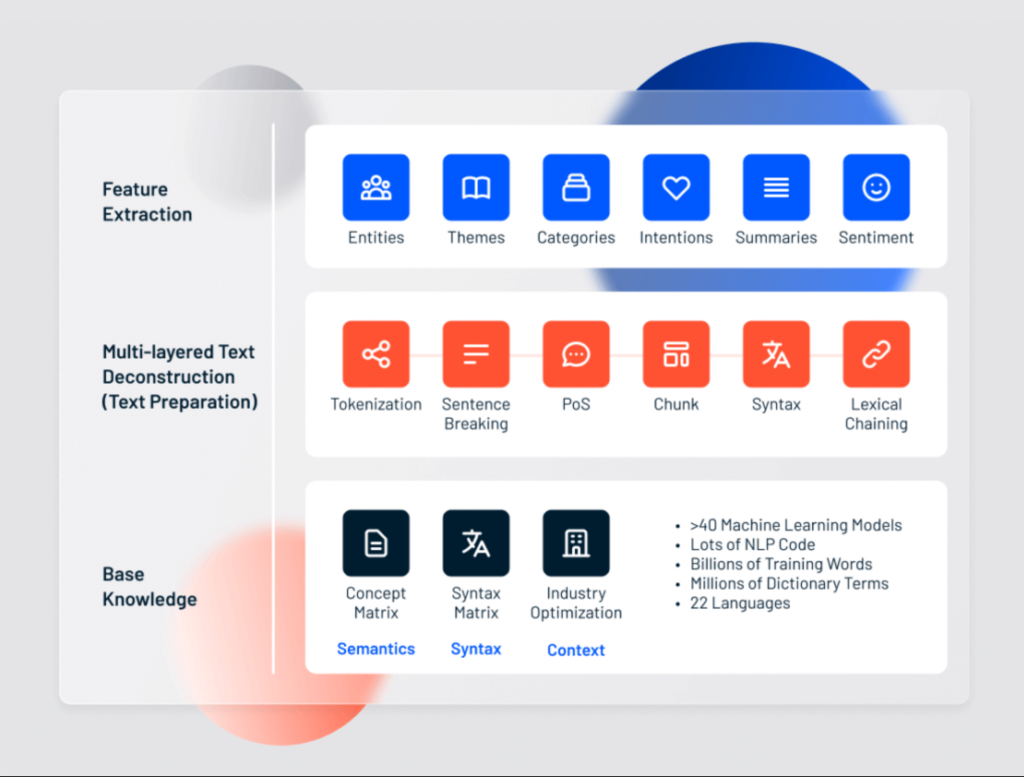
I first ran into Lexalytics while working with a team that needed full control over their data and couldn’t send anything to the cloud. Lexalytics is usually the name that comes up in those conversations. It’s built for situations where sentiment analysis has to be deeply customizable, domain-specific, and deployable in environments with strict compliance rules. Instead of relying on generic models, it gives you the ability to tune taxonomies, classifiers, and analytics pipelines so the output fits your industry and terminology. It’s not plug-and-play, but when teams need precision and control, this is the route they take.
Best For: Enterprises that need deep, customizable NLP with the option to run everything on-premise.
Key Features
- Sentiment, entity, and theme extraction
- Industry-tuned text analytics models
- On-premise and private cloud deployment
- Customizable taxonomies and classification logic
- SDKs and APIs for integrating NLP into existing systems
- Support for multiple languages
Pros
- Flexible deployment, including full on-premise
- Highly customizable for domain-specific use cases
- Strong entity and theme extraction for complex text
Cons
- Requires technical setup and tuning
- Not ideal for teams wanting quick, no-code workflows
Pricing: Starts around $10,000 for basic cloud analytics
User Rating: 4.3/5 (G2)
6. Brandwatch
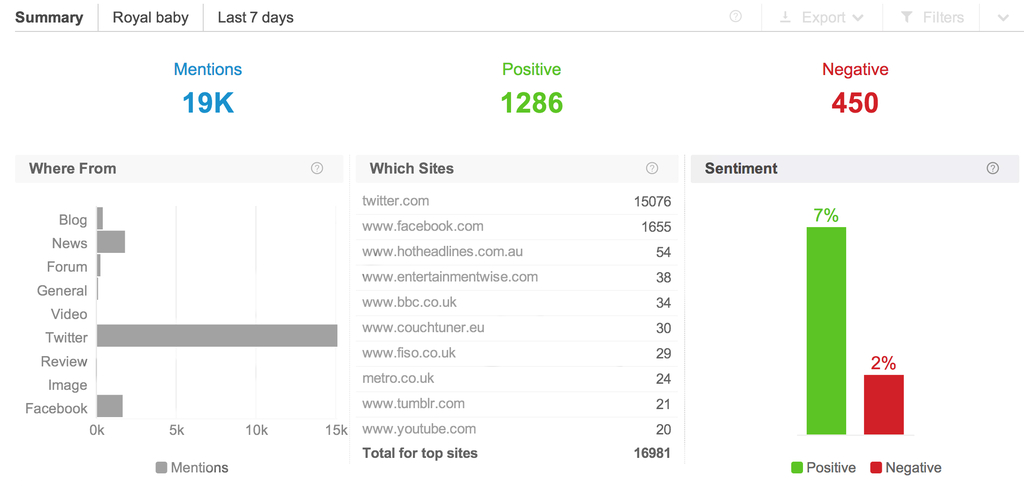
I first heard about Brandwatch from my marketing team that was trying to track how a product launch was being received across social, news, and forums without jumping between ten dashboards. Brandwatch came up because it’s built for that exact problem. Instead of focusing on survey feedback or support tickets, it pulls conversations from the open web and applies sentiment analysis at scale. What teams like about it is the breadth of data. If people are talking about your brand anywhere online, Brandwatch usually picks it up. It’s a strong fit when you need to understand public sentiment, not just customer sentiment.
Best For: Brand, marketing, and social teams that need real-time sentiment across social and web platforms.
Key Features
- Real-time social listening and sentiment detection
- Coverage across social networks, forums, blogs, and news
- Trend tracking, mention categorization, and influencer identification
- Competitive benchmarking
- Custom dashboards and visualizations
- Alerts for spikes in sentiment or brand mentions
- Integrations with analytics and publishing tools
Pros
- Excellent coverage across public channels
- Strong real-time monitoring and alerts
- Useful for campaigns, launches, and reputation tracking
Cons
- Pricing is enterprise-oriented
- Can be more than you need if you’re not focused on social or brand monitoring
Pricing: Custom quote
User Rating: 4.4/5 (G2)
7. Talkwalker
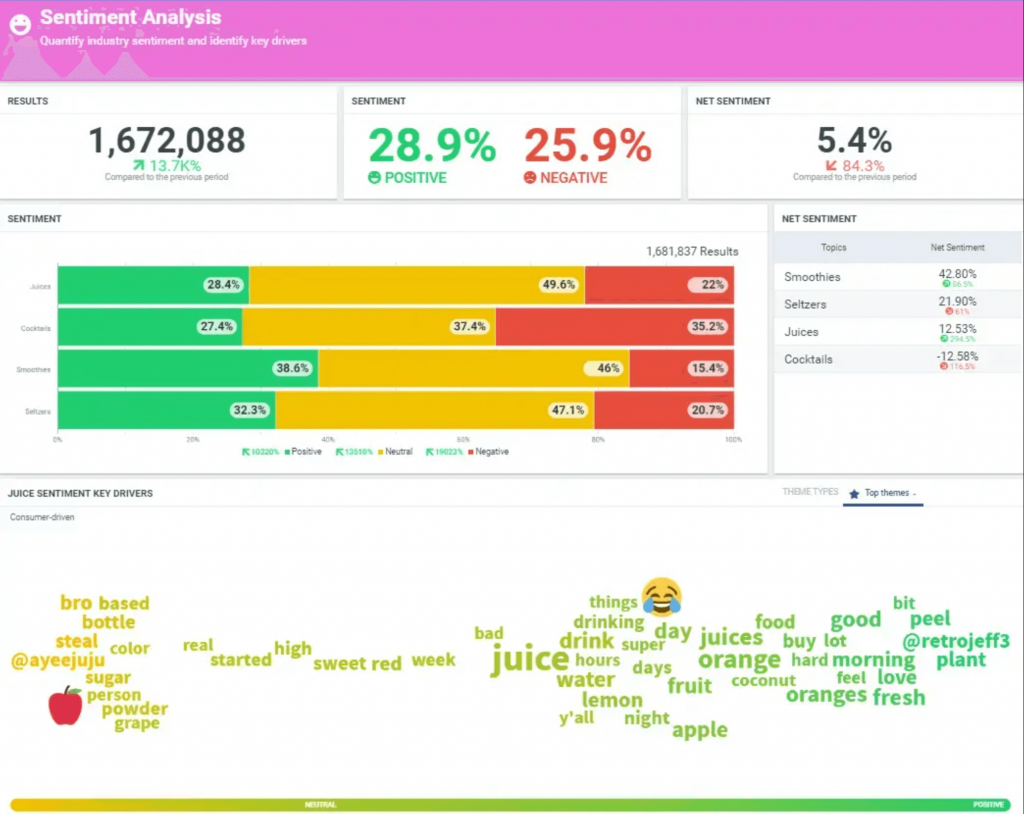
I first noticed Talkwalker when a comms team pulled up a dashboard showing sentiment trends from news outlets, social posts, podcasts, and even TV mentions, all synced in one place. It was the first time I’d seen a tool track how a story evolves across regions and languages without needing five separate platforms. That’s really what Talkwalker is built for. It’s designed for teams that operate in public markets or global categories where conversations happen everywhere, not just on social. When you need visibility across media formats and languages, Talkwalker is usually the tool that comes up.
Best For: Global teams that need multi-channel, multilingual sentiment monitoring across social, news, and media.
Key Features
- Sentiment analysis across social, news, forums, podcasts, and broadcasts
- Multilingual models with broad language support
- Real-time alerts for spikes in mentions or sentiment
- Trend tracking and conversation clustering
- Competitive benchmarking and industry tracking
- Visual analytics and flexible dashboards
- Integrations for reporting and publishing workflows
Pros
- Outstanding multi-language and multi-format coverage
- Strong real-time trend and crisis detection
- Ideal for monitoring global brand perception
Cons
- Enterprise-level pricing
- Can be more than you need if sentiment is only part of your workflow
Pricing: Custom quote
User Rating: 4.3/5 (G2)
8. Sprout Social

A former colleague who runs a social team told me they switched to Sprout Social after juggling separate tools for publishing, engagement, and sentiment. Their takeaway was simple: Sprout isn’t the most “experimental” platform, but it does the fundamentals extremely well. The built-in sentiment analysis is practical. It helps teams understand how audiences react to posts, replies, and campaigns without leaving the dashboard they already use for scheduling and community management. It’s built for teams that live on social platforms all day and want everything in one place.
Best For: Social-management teams that want publishing, engagement, and sentiment analysis in a single workflow.
Key Features
- Sentiment analysis for social conversations and campaign responses
- Unified social inbox for cross-platform engagement
- Publishing, scheduling, and content calendar tools
- Audience insights and performance reporting
- Competitive benchmarking
- Collaboration tools for larger teams
- Integrations with analytics, CRM, and help desk tools
Pros
- Everything happens in one platform
- Clean interface that’s easy for teams to adopt
- Strong for campaign and community sentiment tracking
Cons
- Pricing jumps quickly with team seats
- Limited beyond social channels
Pricing: Starts from $199/seat/month
User Rating: 4.4/5 (G2 & Capterra)
9. Medallia
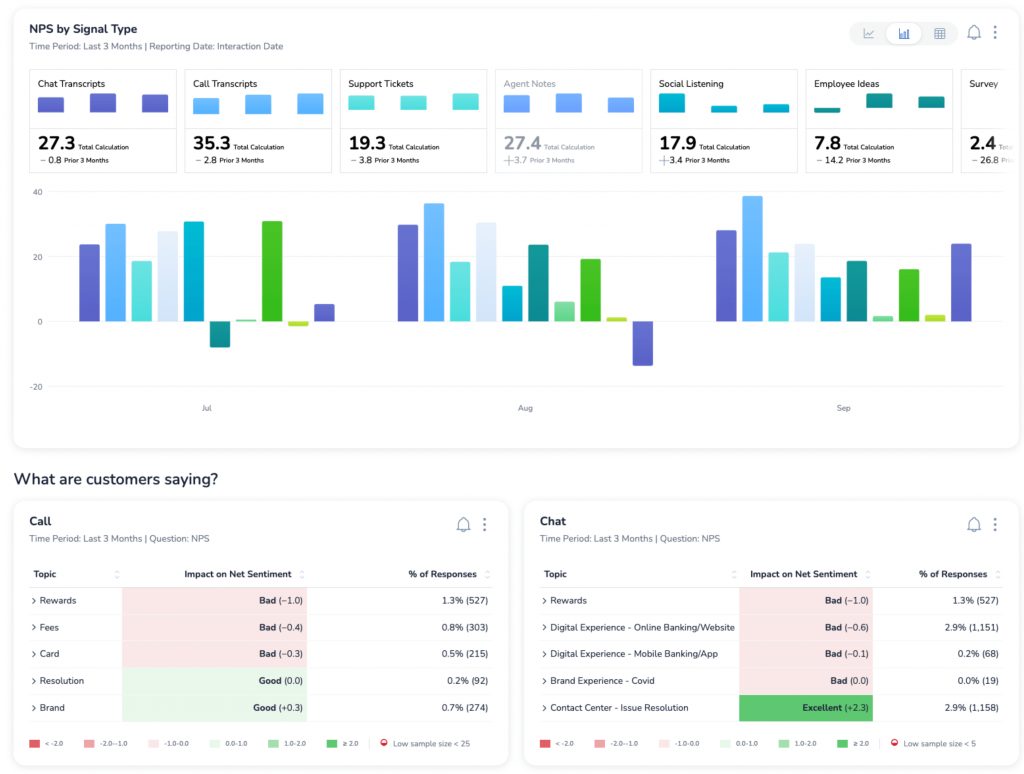
An ex-colleague who moved into enterprise CX told me Medallia was the first tool their team pushed for when they needed to unify feedback from retail locations, apps, support channels, and post-purchase surveys. That’s where Medallia tends to stand out. It isn’t just about sentiment on text responses. It’s about stitching together every touchpoint a customer has with a brand and giving teams a single place to understand what’s working and what isn’t. The sentiment layer sits on top of this broader CX system, making it useful for organizations that collect feedback at scale across multiple channels and teams.
Best For: Large organizations running multi-channel CX programs with high feedback volume.
Key Features
- AI-driven sentiment and text analytics across multiple touchpoints
- VoC collection from web, mobile, in-store, and support channels
- Journey mapping and customer experience dashboards
- Predictive intelligence and risk scoring
- Advanced reporting with segmentation
- Integrations with CRM, support desks, and data warehouses
Pros
- Extremely strong for end-to-end customer experience programs
- Consolidates feedback from many channels into one system
- Robust reporting for enterprise teams
Cons
- Requires time and resources to implement
- Best suited for large organizations, not smaller teams
Pricing: Custom quote
User Rating: 4.5/5 (G2)
10. Amazon Comprehend
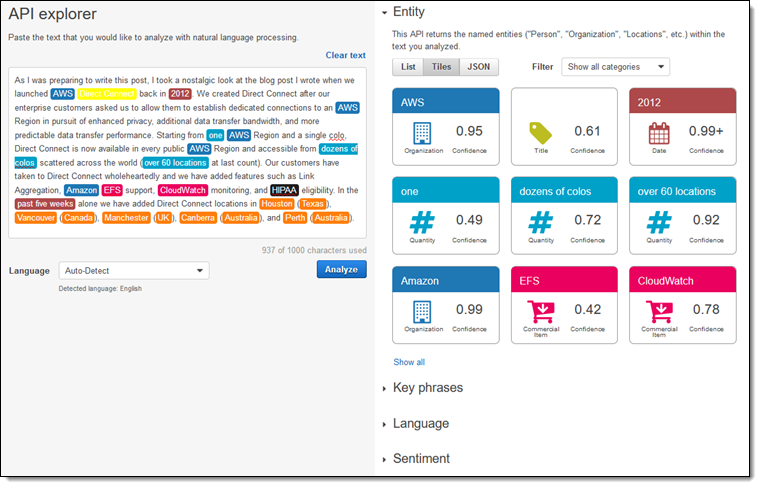
A data engineer I worked with once mentioned that their team chose Amazon Comprehend mostly because it “played nicely with everything else in AWS.” That’s the typical story with Comprehend. It’s less of a standalone sentiment tool and more of an NLP engine you plug into your existing data pipelines. If your feedback already lives in S3, Redshift, or an internal data lake, Comprehend makes it easy to run sentiment, entity extraction, and key phrase analysis at scale without spinning up a separate platform. It’s built for teams that prefer APIs and automation over dashboards.
Best For: Teams already invested in AWS who want sentiment analysis as part of their data pipeline.
Key Features
- API-based sentiment analysis
- Entity, key phrase, and topic extraction
- Targeted sentiment for pinpointing sentiment about specific subjects
- Multi-language support
- Tight integration with S3, Redshift, Lambda, and other AWS services
- Real-time and batch processing options
- Scalable for large datasets
Pros
- Easy to use if your infrastructure is already in AWS
- Highly scalable for large feedback volumes
- Flexible for custom workflows and automation
Cons
- Developer-oriented; not built for non-technical users
- No built-in dashboards or survey workflows
Pricing: Starts from $0.0001 per unit (up to 10M units)
User Rating: 4.2/5 (G2)
My Top 3 Picks
Now that we’ve gone through the full list, here are the three tools that consistently rise to the top. These stand out not because they’re the biggest platforms, but because they solve their specific use cases with the least friction and the most clarity. If you need a quick shortlist without revisiting every review, start here.
1. Qualaroo (Best for Product & UX Teams)
Qualaroo is the strongest option when you need sentiment analysis inside the product experience itself. The nudges capture feedback in context, and the IBM Watson integration handles open-ended responses without any manual tagging. It’s quick to deploy, lightweight, and gives you sentiment insights tied directly to real user behavior.
2. Enterpret (Best for Multi-Channel Feedback)
Enterpret works well when your feedback is spread across support tickets, app reviews, community posts, and surveys. It centralizes everything and uses LLMs to surface themes, drivers, and shifts in sentiment. If you deal with a high volume of fragmented feedback, this is the tool that brings order to the chaos.
3. Sprout Social (Best for Social-Driven Teams)
Sprout Social is the most practical choice if your sentiment signals primarily come from social media. Publishing, engagement, and sentiment happen in the same workflow, which makes it easy for teams to gauge audience reactions without switching tools. It’s built for the pace and rhythm of daily social management.
FREE. All Features. FOREVER!
Try our Forever FREE account with all premium features!
Evaluation Criteria: How I Chose These Sentiment Analysis Tools
Selecting a sentiment analysis tool isn’t about who has the longest feature list. It’s about which tool fits the way you collect and use feedback. Below are the criteria that matter in real workflows, along with clear direction on the tools that perform best in each area.
1. Accuracy and Language Handling: How reliably the tool interprets tone, mixed sentiment, or vague comments across languages. If accuracy on open-ended feedback is your priority, Qualaroo (IBM Watson), Clootrack, and Enterpret consistently produce cleaner, more trustworthy output.
2. Setup and Workflow Fit: How quickly you can go from signup to insight without involving engineering or changing your workflow. For fastest setup, Qualaroo and ProProfs Survey Maker stand out. If you’re technical or already in AWS, Amazon Comprehend fits naturally.
3. Depth of Analysis: Whether the tool goes beyond positive/negative scoring and actually explains what’s driving sentiment. For deeper theme and driver analysis, Enterpret, Clootrack, and Medallia are built for that kind of work.
4. Integrations and Data Flow: How well the tool connects to your existing stack — CRMs, analytics tools, help desks, or data lakes. If you want simple plug-and-play, Qualaroo and ProProfs Survey Maker integrate smoothly with most common workflows. For enterprise pipelines, Medallia, Brandwatch, and Amazon Comprehend offer stronger depth.
5. Scalability: How well the tool handles large datasets or multiple feedback sources as your volume grows. If you’re scaling quickly or dealing with multi-channel feedback, Qualaroo, Enterpret, and Clootrack hold up best.
6. Pricing Practicality: Whether the tool stays affordable as you add more responses, seats, or channels. If predictability matters, ProProfs Survey Maker and Qualaroo offer clear entry points. Enterprise tools like Medallia or Brandwatch make more sense once you have the volume to justify the cost.
7. Use Case Coverage: How well the tool fits its intended workflow — product, CX, research, or social — without forcing workarounds.
- For product and UX, nothing is as straightforward as Qualaroo.
- For survey-heavy workflows, ProProfs Survey Maker is the most flexible.
- For multi-channel product feedback, Enterpret is the strongest fit.
- For brand and social monitoring, Sprout Social, Brandwatch, and Talkwalker are purpose-built.
- For enterprise CX, Medallia is unmatched.
- For data engineering or analytics pipelines, Amazon Comprehend integrates the cleanest.
8. User Ratings: What the market says about the real-world experience: ease of use, support, reliability. Tools with strong, consistent reviews include ProProfs Survey Maker (4.8/5), Qualaroo (4.7/5), and Enterpret (4.5/5). If a tool is highly rated, that often means fewer onboarding woes and better day-to-day performance.
How You Should Choose Yours
Choosing a sentiment analysis tool becomes much easier once you focus on where your feedback actually comes from and how your team plans to use it. Here’s the simplest way to narrow it down.
- If your feedback originates from within your product or website, choose Qualaroo. You’ll capture sentiment at the exact moment users feel friction, which is far more reliable than post-hoc surveys.
- If most of your feedback comes from structured surveys, choose ProProfs Survey Maker. The AI survey builder accelerates creation, and its sentiment analysis is integrated directly into reporting.
- If your feedback is scattered across multiple channels, pick Enterpret. It centralizes support tickets, app reviews, surveys, forums, and community posts into one place and pulls themes together using LLMs.
- If you’re monitoring how the public talks about your brand, use Sprout Social, Brandwatch, or Talkwalker. These tools specialize in real-time social and media sentiment, which product-first platforms often overlook.
- If you’re running an enterprise CX program, go with Medallia. It ties sentiment to journeys, locations, and teams in a way that smaller tools aren’t built for.
- If you live inside AWS and prefer APIs over dashboards, choose Amazon Comprehend. It slots neatly into S3, Redshift, and your existing data pipelines.
- If you need in-depth, domain-specific text analysis or on-premises deployment, choose Lexalytics. It’s built for teams that need complete control, custom taxonomies, or strict compliance.
- And lastly, if your priority is large-scale, multi-language, multi-channel analysis, Clootrack is the safer bet. It handles high-volume review and social datasets better than most platforms.
How Sentiment Analysis Works (Capabilities, Limitations, Accuracy Gaps & Modern AI Advances)
Now that you’ve seen what each tool offers, it’s worth stepping back to understand the technology behind them. Sentiment analysis isn’t flawless, and the differences between tools often come down to how they interpret text, handle nuance, and manage context. This section gives you a clear, practical look at how sentiment analysis actually works, so the strengths and tradeoffs you saw in the tool reviews make more sense.
| Area | What You Should Know |
|---|---|
| What It Can Do | Helps you categorize feedback (positive, negative, neutral, mixed), spot trends, and make large volumes of text easier to process. |
| What It Can’t Reliably Do | Struggles with sarcasm, polite frustration, vague comments, and intent without context. It’s not a replacement for human judgment. |
| The Contextual Accuracy Gap | Sentiment scores often miss the hidden meaning behind polite or indirect language. A comment like “interesting update” can be read completely wrong without behavioral context. |
| Why Sentiment Is a Signal, Not a Decision | Works best as an early indicator, spotting patterns, shifts, or problem areas, rather than diagnosing individual users. |
| Why Misinterpretation Happens | Teams read sentiment scores in isolation, without customer history, product usage, segments, or recent changes. That’s how neutral comments get overvalued and outliers get misread. |
| Traditional Models (Older ML) | Keyword-driven, limited nuance detection, weak with long-form text, often misclassifies sarcastic or mixed statements. |
| Modern LLM Models | Better at understanding tone, subtle emotion, and mixed sentiment. Stronger with long feedback. Many tools (e.g., Qualaroo with IBM Watson, Enterpret, Clootrack) now rely on LLM-style or hybrid models. |
| Examples: Where LLMs Win | “Thanks, I guess this will do” → LLM sees frustration; older models see neutral. “Great, another update we didn’t ask for” → LLM reads negative; older models get tricked by “great.” |
Challenges With Using Sentiment Analysis Tools
Even the best sentiment tools come with limitations. Most teams run into the same issues once they start using them at scale. Here’s what to expect so you can plan around the gaps rather than be surprised by them.
1. Accuracy Isn’t Perfect: Sarcasm, indirect phrasing, and mixed emotions still get misclassified, even with advanced models.
2. Sentiment Without Context Misleads: A score means little without usage data, segments, or customer history beside it.
3. Too Much Weight on Single Comments: Teams often treat sentiment as a verdict instead of a directional signal.
4. Integration Gaps: Some tools don’t connect cleanly to CRMs, analytics platforms, or data warehouses, creating manual work.
5. Scalability Limits: High-volume periods can slow tools down or reduce scoring consistency.
6. Pricing Can Spike Quickly: Costs often rise with response volume, channels, or team seats.
7. Channel Mismatch: Survey tools aren’t great for social sentiment, and social tools aren’t ideal for product feedback.
The Bottom Line on Choosing Sentiment Analysis Tools
Choosing the right sentiment analysis tool comes down to where your feedback actually lives and how quickly you need to turn that feedback into something actionable. The tools in this list all serve different purposes: some are built for social monitoring, some for enterprise CX, and some for multi-channel analysis at scale.
If your priority is to understand what users feel inside your product, a lightweight, in-context option like Qualaroo will give you far more clarity than any after-the-fact survey or social tool.
The key is matching the tool to the workflow, not the other way around. Once you do that, sentiment stops being a guess and starts becoming a reliable input into your product and customer decisions.
Frequently Asked Questions
What is the best AI for sentiment analysis?
It depends on the workflow. For in-product feedback, tools like Qualaroo, powered by IBM Watson, perform consistently well. For multi-channel feedback at scale, Enterpret and Clootrack use LLM-driven models that surface themes and drivers, not just sentiment scores. There’s no universal “best”; there’s only the best fit for where your feedback comes from.
Can you do sentiment analysis in Excel?
Not natively. You can import results from APIs or third-party tools into Excel, but Excel itself can’t interpret tone or classify text. Most teams export scored data into Excel or Sheets after running sentiment through tools like Qualaroo, ProProfs Survey Maker, or an NLP API.
How is NLP used in sentiment analysis?
NLP breaks down text into components—words, phrases, entities, context—and uses models to determine emotional tone. This is especially useful in situations described in your ICP data, where teams need to process open-ended survey responses or qualitative user feedback at scale. NLP turns those free-form comments into structured sentiment categories that are easier to analyze and act on.
How does sentiment analysis help with open-ended survey responses?
Sentiment analysis turns long, qualitative comments into structured insights you can actually act on. Instead of scanning hundreds of open-ended responses, the system scores tone, highlights recurring themes, and flags negative trends automatically. This is especially useful for teams running CSAT, NPS, or UX surveys where users often leave optional comments. What would normally take hours of manual reading becomes a clear set of patterns your product or UX team can work with right away.
FREE. All Features. FOREVER!
Try our Forever FREE account with all premium features!

 We'd love your feedback!
We'd love your feedback! Thanks for your feedback!
Thanks for your feedback!





